Back to: Table of Contents | Prologue
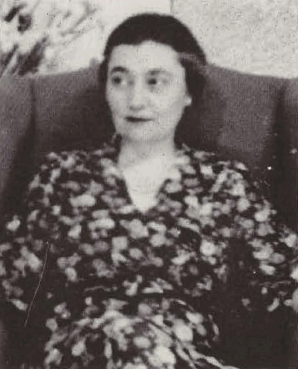
Ann Preston Bridgers, playwright and first sponsor of Raleigh Little Theatre
There may have been worse times to start a new theatre, but it would take an inspired playwright to invent them. The year was 1936. The world was still mired in the Great Depression and there were rumblings from Europe and the Far East, the preliminary skirmishings of World War II. Closer to home, Franklin Roosevelt was winding up his first term and North Carolinians were wondering if they would ever turn the corner where those promised “good times” supposedly lay waiting.
Hardly a time for a new venture in the arts, but a group of stagestruck Raleigh men and women thought otherwise. There had been earlier, unsuccessful attempts in the late 1920s and early 1930s to form an amateur theatrical group in the state’s capital, but the dismal history didn’t discourage RLT’s founders.
They might have had second thoughts had they known what was ahead-a battle with the federal bureaucracy that might have been funny had it not been so calculatedly frustrating and near-disastrous; the lean war years when men, money and materials were in short supply; and the countless clashes of personality, culminating in one instance in the firing of a director after a bitter dispute.
But all that was in the future, along with the good times-the slow, steady development of a reputation for quality and dedication to the craft of theatre, and a thousand or so enchanted nights when the stage worked its old and beautiful magic for cast, crew and audience.
The success of RLT’s founders was probably due in no small part to what was once called a “happy coincidence”. The description is by Donald J. Rulfs in “A Brief History of the Raleigh Little Theatre,” written for the Playbill distributed at RLT’s 100th production in 1955. Rulfs explained this way:
“The Raleigh Little Theatre had its beginnings as the result of the combined interests of several local young people desirous of forming a small theatre group in cooperation with technical workers of the Federal Theatre. It was indeed a happy coincidence that just at the time the local group was attempting to establish an organization, the Federal Theatre was seeking local groups with which to organize technical theatre workers under a professional director.”
The Federal Theatre project was part of the vast umbrella of New Deal organizations developed under the administration of President Franklin D. Roosevelt that reshaped American society. The theatre, along with every other part of the nation’s economy, had been devastated by the Depression, and the Federal Theatre project was an effort to find jobs for the thousands of unemployed playwrights, directors, actors and technicians. Part of the federal money was earmarked for regional theatre, and that is where Raleigh entered the picture.
In the winter of 1935-36, Mary Dirnberger, state director of the Federal Theatre, asked Jonathan Daniels, editor of The News and Observer, and Ann Preston Bridgers, Raleigh playwright, for suggestions on how a local theatrical group might work with employees of the Federal Theatre. With the approval of May E. Campbell, state director of the Women’s and Professional Division of the Works Progress Administration (WPA), another New Deal agency, Miss Dirnberger brought together Federal Theatre workers and a local group that included Sadie Root, Betty Rose Phillips, Lynn Wilder, Heath Long, James Thompson, Lucy Dortch, Boris Petroff, Dr. Walter Cutter, Joe Moye, Molly Winborne, Sybil Berwanger, Allen Thurman and Jessie Mills.
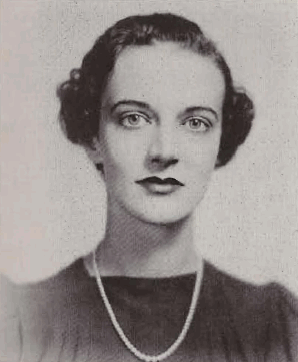
Sadie Root, first president of Raleigh Little Theatre
Earlier, in the summer of 1935, Sadie Root and several others had spent their spare time poking around in old barns and sheds in the Raleigh area, hoping to find a spot that would serve as a theatre. Their dreams moved toward reality when Miss Dirnberger got together and arranged a meeting between federal and local theatre people in late January 1936 at the home of Lucy Dortch. They made plans for a Little Theatre to be operated as a community venture with production staff and guidance furnished by the Federal Theatre.
Miss Bridgers was named adviser of the newly formed group, with her chief duty the coordination of efforts by the Federal Theatre and the Raleigh Little Theatre. Named to an advisory board were editor Daniels, Mrs. Louis V. Sutton, Mr. and Mrs. Charles A. Johnson, Nell Battle Lewis, Lodwick Hartley, Mrs. John M. Anderson and William Jones. The advisory board was to meet in Daniels’ office at The News and Observer whenever a crisis arose.
In a 1949 report, Miss Bridgers recalled the purpose of the newly formed theatre:
“The purpose of the Little Theatre from its very beginnings was to build a democratic organization wherein the people of the community were welcomed to find recreation and creative outlet. The trend has never been toward a closed membership, the emphasis being laid at all times on creative, not social, ends. This fell in, of course, with the aim of the Federal Theatre.”
Miss Bridgers was quick to acknowledge the Little Theatre’s debt to its federal parent:
“I think it should be stressed … that the Raleigh Little Theatre is the child of the Federal Theatre, and its amazing success in becoming a vital part of the life of the community of Raleigh … was due to the vision and actual aid of the Federal Theatre.”
The first meeting of the newly organized theatre took place the evening of February 11, 1936, at Hugh Morson High School. Sadie Root was elected president. Frederick Koch, famed director of the Carolina Playmakers at the University of North Carolina at Chapel Hill and regional adviser of the Federal Theatre, addressed the RLT meeting, and. his Playmakers presented a new folk play, “Strike Up a Tune, Sister;” written by Patsy McMullen.
Memberships in the Raleigh Little Theatre began to trickle in, and the group held regular meetings at various sites, including the Sir Walter Hotel and Murphey School. Several one-act plays were presented, among them “The Twelve Pound Look,” “The Proposal,” “Overtones,” and “East of Eden.”
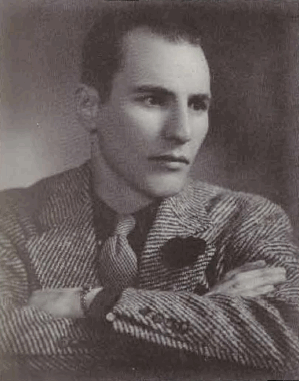
Kay McKay, First Director of Raleigh Little Theatre, 1936
It was a difficult time of discovery and exploration, the first effort in the nation to develop a partnership between the Federal Theatre and a community group, and Professor Koch responded generously and often to pleas for help from the infant little theatre.
Mrs. Campbell, WPA’s state director of the Women’s and Professional Division, had to create her own precedents for blending the work of professionals and volunteers without ignoring the requirements of the federal bureaucracy and its inevitable red tape. George J. Spence, in his master’s thesis prepared for the Graduate School of Florida State University, said Mrs. Campbell “succeeded not only in ironing out technical and organizational difficulties, but in smoothing away temperamental clashes between those working directly under her supervision and the sometimes unruly volunteers whose nerves reacted in typical backstage theatre patterns.” Which presumably translates as meaning she was skilled at treating temper tantrums and massaging bruised egos.
Raleigh Little Theatre took a major step forward in March 1936 when Kay McKay was sent to Raleigh as a regular, paid director of RLT. McKay became available with the closing of the Federal Theatres production of “Jefferson Davis” in Chapel Hill, for which he had been a senior supervisor.
A story by Hoke Norris in the Sunday, April 12, 1936, News and Observer, introduced McKay to Raleigh, recalling how the 35-year-old actor-director got his start in show business at the age of nine on a Mississippi plantation, directing Saturday afternoon “drammers” in one of the farm’s big barns, charging two cents a head admission and serving lemonade and cookies provided by his mother.
McKay brought considerable experience to his new job. He had appeared with professional companies on the West Coast and on Broadway and helped make radio history as a member of the cast of the first radio drama-Avery Hopwood’s “The Alarm Clock.”
The story about McKay also stressed the federal role in the Raleigh Little Theatre-that Raleigh was the first community to receive the “loan” of a professional director as part of “the federal government’s initial step into the dramatic arts, taken to return the theatre to the people.”
McKay also had some dreams for the future of the Raleigh Little Theatre:
“We want to make the Raleigh Little Theatre group a permanent institution…. I have never seen so much extraordinary talent as there is in Raleigh. It’s amazing…. I feel that I’m back again where people know the graciousness of living-an art which has been lost in the North, particularly in New York.”
Asked about long-term plans, McKay said they included a permanent building for the Little Theatre, a membership of 2,000, a continuous series of plays and a contest to select a new name for the organization. Except for his comments on the name change, not a bad reading of the crystal ball.
McKay chose as the first production of the Little Theatre that venerable melodrama, “The Drunkard,” by P.T. Barnum as adapted by W.H. Smith.
“It was written in all seriousness by Barnum, who never took a drink,” McKay explained, “and we are going to stage it just as seriously, just as if we were trying to lift the morals of the community. That’s what’s going to be so funny about it. We’ll have period costumes and setting, and the very seriousness of our interpretation will be its great attraction.”
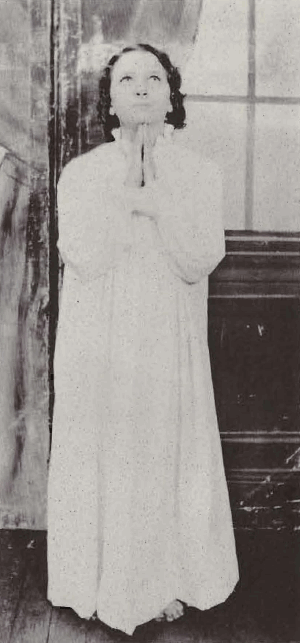
Production photo from Raleigh Little Theatre’s first production, “The Drunkard,” 1936
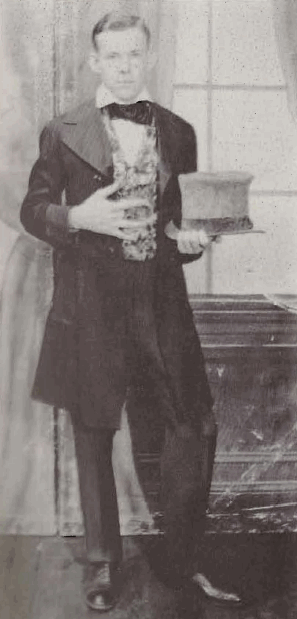
Production photo from Raleigh Little Theatre’s first production, “The Drunkard,” 1936
Enlisting the help of the technical staff of the ‘Jefferson Davis” company which he had just left. McKay was able to stage and costume “The Drunkard” far beyond typical amateur standards. Since it was the Raleigh Little Theatre’s first big production, the show enjoyed a spate of advance publicity that would be the envy of today’s Little Theatre. In addition to promoting ticket sales, the feature stories also left a valuable historical record of how that first RLT show was put together. An account in the May 3, 1936, News &Observer, for example, describes a rehearsal for “The Drunkard”:
“Allan Thurman went down with a fairly convincing thud, sprawled on the stage of the Murphey School auditorium. Finally, he staggered to his feet, wiped his beady brow. ‘Walk,’ he muttered. ‘Yes, I can walk…. What’s the matter with my head? Blood? …’.
“‘No, no, NO; yelled Kay McKay, who was standing down on the auditorium floor, resting his elbow on the corner of the stage and watching Thurman.
“‘Not blood.’ said McKay ‘BU’LUD,’ he bellowed. ‘BU-LUD,’ echoed Allan Thurman. And the rehearsal of ‘The Drunkard’ proceeded.”
A week later, another N&O reporter, Louise Allen, checked out the technical side of the production:
“The Little Theatre workshop is located on the third floor of the building which houses the North State Cafe. I wanted to smell the paint, and to see the grime, the dirt, the toil that goes on in a dramatic workshop.”
Miss Allen apparently was impressed with what she found in the way of scenery, the olio (front curtain), Broadway scene, woodland drop, and parlor scene, designed by McKay and executed largely by Primrose McPherson and Mr. and Mrs. Stephen Blankenship, assisted by members of the Little Theatre. Commented Miss Allen:
“Written out across the olio (I use that name in deference to those who are more experienced in terms of the Drama) is the traditional ASBESTOS. On the right, a gal of the Mae West variety will make you look twice. She’s wearing a ‘costume’ of raspberry red and chartreuse, with a string of gold beads to match her golden tresses. On one hand rests a bird, which is a cross between a cuckoo and a canary. In the other, she carried a staff.
“…Distinctly of the burlesque variety, these backdrops should add much to the presentation of this melodrama, which set sophisticated New Yorkers and blasé Hollywoodonians howling with laughter.”
Another advance story quoted director McKay as saying: “This is going to be the most elaborate production in Raleigh since ‘Ben Hur.'”
For those who might be worried, the reporter elaborated: “There will be no chariot races in ‘The Drunkard.’ The stage of the Murphey School auditorium isn’t large enough, even if the script called for them.
“But the production’s got everything except horses,” McKay claimed. “It will be presented this coming Wednesday, Thursday and Friday nights in the Murphey auditorium. A private performance for members of the Raleigh Little Theatre only will be given Tuesday evening.
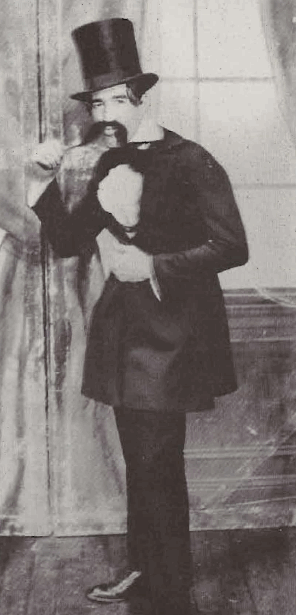
Production photo from Raleigh Little Theatre’s first production, “The Drunkard,” 1936
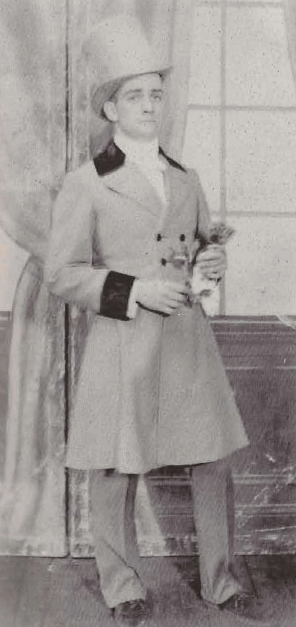
Production photo from Raleigh Little Theatre’s first production, “The Drunkard,” 1936
“To re-create the atmosphere in which the ancient and lachrymose melodrama first was presented, the audience will be invited to hiss the villain, in the person of Curtis Muse, as much as they please.
“Peanuts and soft drinks will be sold in the audience between acts, in the best music hall tradition, and period music will be played by ‘Professor’ Anna Oldham.”
After that kind of press build-up, a flop would have been unthinkable. McKay and company needn’t have worried. They had a hit on their hands. A review signed only with the initials “c.JP’ in The News and Observer had the kind of language that lets press agents reprint without judicious editing:
“Don’t miss it. Unless you have, or are entitled to, gray hair, you have never seen anything like it. This is a professional production, and it is thoroughly professional from the scenery executed by Miss Primrose McPherson to the happy ending directed by Mr. Kay McKay of the Works Progress Administration’s Federal Theatre Project.
“It was so good that Guy Standing Jr., who played the title role in ‘Jefferson Davis,’ doubled up with laughter in his front row seat and expressed his indignation by throwing peanuts at the villain.”
Writing in The Raleigh Times, Bob Mason said:
“Applause sent the curtain up twice at the end of the performance, a just tribute to Miss Sadie Root, president of the Raleigh Little Theatre, and her associates, and Mr. Kay McKay of the WPA Federal Theatre Project, who directed the masterful melodrama. The majority of those present were frank in the opinion that the production far exceeded expectations.”
The local newspapers had based their first reviews on a preview performance for RLT members and sent reporters back for the first public performance. Again the reviews were enthusiastic, with one minor reservation by an unnamed reporter for The N&O:
“Youngsters brought up in the tradition of 10 cents every Saturday for a Buck Jones western movie and oldsters who’ve had a hard time remembering how to applaud between occasional road shows rediscovered their vocal cords and cheered, yelled, booed, and hissed ‘The Drunkard.’
“They also discovered a new and diverting indoor sport-hurling peanuts at living actors on an open stage. The management invited the peanut barrage and the audience took the management at its word, and pitched a pop bottle onto the stage in the barroom scene for good measure. Curtis Muse, the dastardly villain of the piece, was the target.
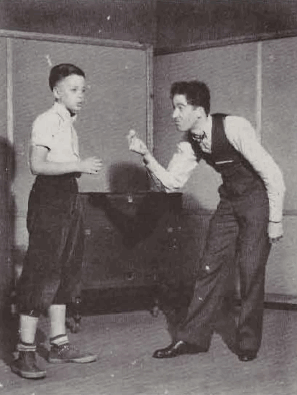
Curtis Muse tempts Aldert Root Jr. in “The Drunkard,” 1936
“To those who wanted to see more of the best local-talent acting done here in many a day, the peanut-throwing seemed overdone, and there were suggestions that the participation of the audience henceforth be limited to hisses and hurrahs.”
Most of the cast of “The Drunkard” had some previous stage experience, and three had studied drama with the Carolina Playmakers. They were Allan Thurman, who played Edward Middleton, the drunkard; Muse, the mustachioed villain, in real life head bookkeeper in the Raleigh office of Wachovia Bank & Trust Co., who had appeared in “Romeo and Juliet” and other productions of the Playmakers; and Sybille Berwanger as Mary Wilson, the heroine, who had been seen in Playmakers’ productions of ‘The Importance of Being Earnest” and ‘Job’s Kinfolks.”
Also in the cast of “The Drunkard” were Mary Burton, William Dameron, Mrs. W.H. Bond, Heath Long, Joe Moye, C.T. Hall, Phyllis Albright, Jim McKee, Frank Howell, Lynn Wilder Jr., Robert Ponton, Key Hart, Logan Howell, Betty Ferguson, J.B. Hunt Jr., Aldert Root and Al Moore.
“The Drunkard” was presented May 13, 14, and 15, 1936, at Murphey School and was such a success that the Little Theatre took the show on the road-to Sanford and a performance May 30, 1936, in the high school auditorium.
The News and Observer reported on RLT’s out-of-town triumph in a dispatch from Sanford printed June 1, 1936:
“The Federal Theatre production, ‘The Drunkard,’ enacted by the Raleigh Little Theatre Players, made a hit with the audience on Saturday evening, when it was presented here in the high school auditorium.
“Gaily attired in hoop skirts, long tail coats and high silk hats, the players cleverly reproduced the philosophy and atmosphere of the 1880s.”
Then, in a burst of unexpected candor, the correspondent added: “The rollicking laughter caused by the burlesque was further augmented by the most efficient claque, which accompanied the players from Raleigh.”
The success of “The Drunkard” was important for a number of reasons: It met an obvious need in Raleigh for a little theatre group for both performers and audiences; it gave name recognition around the state for the new theatrical venture; and, perhaps most important, it set a high standard for future productions, a standard that has endured to the present day.
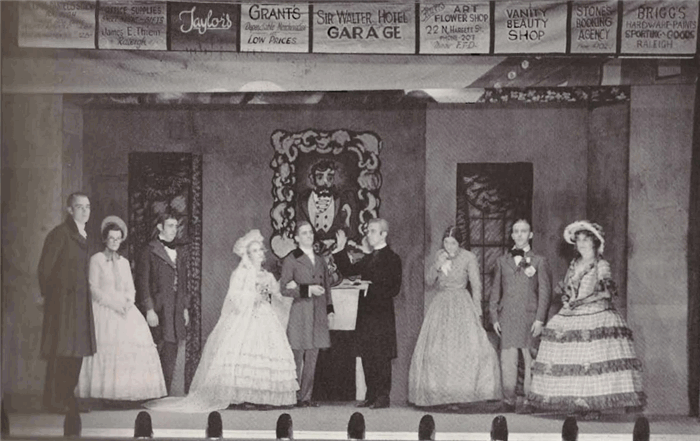
Scene from “The Drunkard” presented in the Murphey School Auditorium, 1936. Left to right, Jim McKee, Phyllis Albright, William Dameron, Sybille Berwanger, Allan Thurman, Joe Moye, (unidentified), Clyde T Hall and Mary Burton.
The Raleigh Little Theatre took a giant step forward artistically with its second production, “Quicksand,” a modern psychological tragedy by Ann Preston Bridgers.
Performances of the play, the first original script produced by the Little Theatre, were June 30 and July 1 and 2, 1936, once again at Murphey School.
A review of the play in The News and Observer of June 30, 1936, is of special interest because of the author. He is identified in the newspaper only as “ECD. Jr.,” almost certainly the initials of E. Clifton Daniel Jr., who at the time was a writer for The N&O and later became a top executive with The New York Times and married President Truman’s daughter Margaret.
The N&O review said in part:
“An excellent piece of playwriting by Ann Preston Bridgers…. The latest product of Miss Bridgers’ pen appears to have been worth the years of thought which she devoted to it-all the years since she left Smith College to become an actress and a playwright for the New York stage.
‘The play should be welcome in New York, where Miss Bridgers intends to have it produced first, though she has had several offers from motion picture companies for the script. It promises to be her second Broadway success. ‘Coquette’ was her first.”
So much for the play. As for the performances, ECD Jr. said:
‘The production was not all that New York will expect to see when ‘Quicksand’ reaches there. But that was to be expected. The obvious fact that stenographers, lawyers and press agents who play-act only in their spare time, cannot be converted into professional performers merely by the magic of Kay McKay’s directing, should not keep anyone from seeing ‘Quicksand.’ It is definitely worthwhile.
“The performance, as well as the play, was the most substantial thing ever presented by amateurs in Raleigh. It signalized a welcome departure from the black-face minstrels and ‘Deestrick Skule’ tradition of home-talent dramatics here and elsewhere in North Carolina.
“The first production of the Little Theatre, a lampooning of ‘The Drunkard’ was a simpler, easier thing to do than ‘Quicksand; as comedy is always less difficult than tragedy. And The Drunkard’ appeared to have been enjoyed immensely by the audience.
“Nevertheless, the production of ‘Quicksand’ was a far more commendable effort by the Little Theatre than its first play, though the players failed last night to evoke from Miss Bridgers’ script all the dramatic power which she wrote into it. The illusion of force, direction and unity in the drama was lost completely at times. Climaxes were built up so shakily that they toppled before they reached their peak.”
The reviewer from The Raleigh Times, one “R.H.M.,” was not so analytical but also liked the production, beginning his comments:
“Applause that swept Murphey School Auditorium Monday night assured the Raleigh Little Theatre that it’s a grown-up organization, capable of portraying out-of-the-ordinary characters and of handling lines and scenes that would give even professionals trouble.”
The reviews of “Quicksand” are worth noting because they indicate that even with its second production, representatives of the local press were measuring the Little Theatre by standards considerably above those usually applied to amateur theatricals.
The cast of “Quicksand” included Vass Shepherd, Anna Oldham, Nellie Small, Jessie Mills, Molly Winborne, Key Hart, Jane Virginia Andrews, Laura L. Edwards, Joe Moye and Clifton Beckwith. They were true Raleigh theatre pioneers as they brought to life RLT’s first original script.
Three black women, loaned from the Negro Adult Group of the Federal Theatre Project, were featured in “Quicksand.” The Times reviewer mentioned all three:
“As predicted by those who had seen ‘Quicksand’ in rehearsal, Laura Edwards, a Negro woman, bought the first act with her laugh and flattering speeches to Mrs. Latimer. Nellie Small, another Negro, played the part of a maid, and Parthenia Day, a third, sang a ‘misery’ song offstage.”
Encouraged by the success of “Quicksand,” the Little Theatre next planned a production of “Heaven Bound,” a black morality play first produced in Atlanta. The Raleigh version was written by the same Laura Edwards who won critical praise for her acting in “Quicksand.” The play had an unusual history. Known also by the titles “Heaven Bound Pilgrims,” “Heavenly Gates” and “Pearly Gates,” the play had never been written down but, like black spirituals, had survived by oral tradition. Miss Edwards’ version had been performed as early as 1933 in Raleigh’s black churches.
Tragedy struck the young theatre before rehearsals for “Heaven Bound” could begin. Director Kay McKay had gone to New York to arrange for costumes when he was stricken by illness and died July 19, 1936.
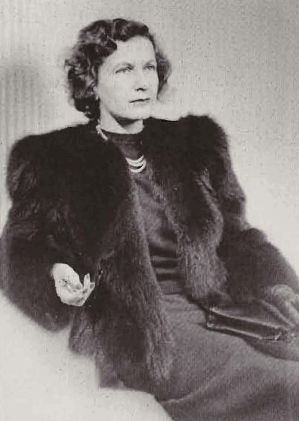
Marion Tatum, director of “Heaven Bound,” 1936
His death occurred before rehearsals had started for “Heaven Bound,” and consideration was given to canceling the production. But Marion Tatum of Raleigh, former member of the Carolina Playmakers and head of the drama department at Hood College in Frederick, Maryland, was home for the summer and was persuaded to take over as director. After intensive rehearsals she had the play ready to open August 30 at Raleigh’s Memorial Auditorium. The News and Observer reported that even before the play opened it had received “high praise from Miss Ann Bridgers, Raleigh playwright, and Ambassador and Mrs. Josephus Daniels, for whom a special performance was given some time ago.”
Employees of the Federal Theatre served as production staff for “Heaven Bound,” and the cast was made up of more than 100 Raleigh area black men and women. A Federal Theatre report said between 4,000 and 5,000 people, mostly black, filled the auditorium for the opening, “the largest number ever to attend a theatrical performance in Raleigh. Police estimated that 1,500 people were turned away. The presentation was elaborately staged and brilliantly lighted and conveyed a feeling of spiritualism quite apart from reality.”
The Raleigh Times review of the production said: “Though the soloists in instances were disappointing, the heavenly choir of over 50 voices performed in a masterly way to give the record audience a treat that will be remembered here… It was the third success of the Raleigh Little Theatre, whose presentations… have brought renown to its short career.”
After the successful presentation of “Heaven Bound,” Miss Tatum returned to Hood College and Wilbur Dorsett, later at Rollins College, was appointed director of the Raleigh Little Theatre. Dorsett, a graduate of the University of North Carolina, had most recently worked as technical director of the New England Repertory Company of Maplewood, New Hampshire. One of his first steps was to seek new members and to reorganize the theatre staff.
“I have found that in the sheer energy required by a small number of workers in producing these three shows, little attention had been given to organizing the Little Theatre,” Dorsett said. “It has been my simple policy from that time to add to the membership slowly but surely and strengthen the group from the core outward.”
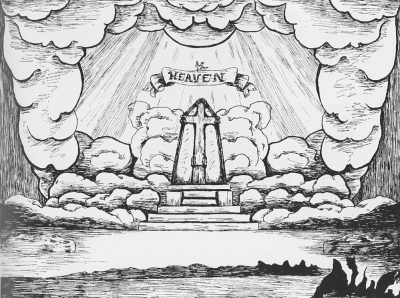
Original sketch of design for the set of “Heaven Bound,” presented in Raleigh’s Memorial Auditorium to an overflow crowd in 1936. The sketch was executed by Marion Tatum who also directed the production. Miss Tatum married Foster Fitz-Simons in 1940. Raleigh Little Theatre’s current Artistic Director, Haskell Fitz-Simons, is their son.
Dorsett set up regular workshop classes in play-reading, directing, acting and technical work; scheduled monthly meetings at which one or two one-act plays were given; and made an effort to bring new faces into each production to find new talent and give all who were interested an opportunity to go on stage.
For his first production, Dorsett directed “The Torch Bearers,” a satire of amateur theatricals. During rehearsals for the play, the growing importance of RLT was demonstrated when the theatre played host to a tri-state conference on WPA women’s and professional projects. Delegates saw a special performance of “The Torch Bearers,” and Dr. Koch, director of the Carolina Playmakers, noted the importance of what RLT was doing: “Designed primarily to give theatre workers employment, the Federal Theatre project is already more than an emergency measure.”
The general public got its first look at the show November 10, 1936. The N&O reviewer was to the point: ‘The Raleigh Little Theatre has another hit. Like the first one, the fourth hit is a comedy smash-George Kelly’s almost unreasonably funny satire on amateur dramatics, The Torch Bearers:” Another N&O writer, Fred J. Mahler, commented: “The Little Theatre definitely has come to occupy a fixed place in the cultural as well as the entertainment phase of Raleigh life.”
Director Wilbur Dorsett has left a description of the adaptability required of cast and crew as they did their work in rented quarters on the third floor of the Wright Building, later called the Academy Building:
“Our rehearsal for ‘The Torch Bearers’ was really torch-bearing. We worked in one side of our top story while they were tearing up the floor on the other and then moved over on the new floor while the other half was being torn up. Scenery was painted by bringing up water in buckets from a service station a block away. This scenery had to be let down from the windows by ropes to a truck three stories below.”
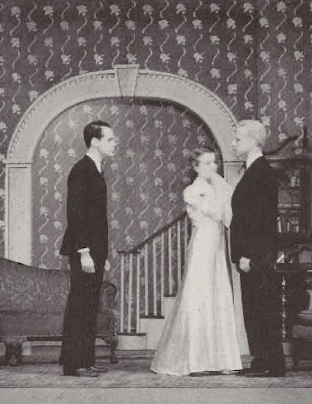
Sam Leager confronts Helen Bailey and Joseph Moye in “Coquette” (1937)
During October and November of 1936, the Little Theatre was busy looking for better quarters. About December 1, several rooms were located on the third floor of the Briggs Hardware building on Fayetteville Street. RLT members cleaned and painted, set up an office, a wardrobe room, a paint room and an “auditorium” for rehearsals and workshop plays. The auditorium contained a small stage with proscenium, front curtain and lighting.
The Raleigh Little Theatre took a giant step January 15, 1937, with the filing of incorporation papers with North Carolina Secretary of State Thad Eure. Incorporators were listed as Sadie Root, Molly Winborne, Heath Long and others.
Meantime, rehearsals had been underway for another play by Ann Bridgers, “Coquette.” It was a state premiere for the play, which had been a Broadway success. Performances were given January 20, 21 and 22, 1937. Another performance January 28 raised money for flood victims in the Midwest, and “Coquette” was presented again on January 29 as part of the regular season of the Rocky Mount Little Theatre Players. Total attendance for “Coquette” was estimated at 1,350.
And critical response was good. Nell Battle Lewis wrote in her News and Observer column that “the atmosphere of the local production seemed more natural than that of the one in New York, and why not? No one was straining to be Southern.” Hoke Norris, writing The News and Observer review of the play, said: “The audience liked the play and was liberal with applause when the curtain closed on one of the most dramatic scenes in the history of the modern theatre…. Special praise for acting must go to Mrs. Howard Bailey, in the part of Norma.”
Besides Mrs. Bailey, members of the cast included CJ. Mcinnis Jr., Joe Moye, William McGehee, Frances Douglas, Martin Green, Hattie Peterson, Sam Leager, William Dameron, Glenna Glover and Lynn Wilder Jr. The setting was designed by Katherine Norris and Anna Riddick.
The Raleigh Little Theatre now had a bit of an arithmetic problem on its hands. Season membership tickets had expired with “The Torch Bearers.” To get its regular season on a September-to-September basis, the custom with other nonprofessional theatre groups, RLT had to have a “three-fourths season” from January to September 1937.
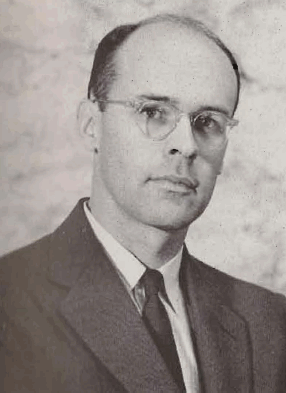
Sam Leager, actor and member of the Board of Directors, Business Manager of Raleigh Little Theatre, 1937-1938
For variety, the theatre next presented AA Milne’s comedy-mystery, “The Perfect Alibi.” which The Raleigh Times called “the best production the Raleigh Little Theatre has given thus far.” Sam Leager and Olga Dodds Hodges had the lead roles.
On March 24, 1937, RLT tested its quality by entering the spring tournament of the Carolina Dramatic Association, sponsored by the Carolina Playmakers at UNC. Thirty-one plays, 14 of them original, were performed during the four-day festival which brought drama groups from allover the state to Chapel Hill. The Rocky Mount Little Theatre won first prize with a production of “Ile.” but the fledgling Raleigh Little Theatre placed second with a performance of Susan Glaspell’s “Trifles,” with a cast that included Elizabeth Bond, Helen Bailey, Key Hart, Martin Green and Robert Ponton.
The next production on the RLT stage was a revival of Moliere’s “The Would-Be Gentleman” (“Le Bourgeois Gentilhomme”), a conscious effort by the theatre to pay more attention to the classics of drama. Baker Wynne, who taught English and speech at what was then State College, won the title role. “The Would-Be Gentleman” was presented May 18, 20 and 21, marking the first anniversary of the Little Theatre.
It had been a busy and rewarding year, setting a standard for excellence that would be hard to match today, even with the vast improvement in resources and membership of the Raleigh Little Theatre. In its first year, RLT had produced seven shows and nine workshop productions. There also were Sunday afternoon playreadings of Molnar’s “Liliom.” Ibsen’s “Hedda Gabler” and Anderson’s “Wingless Victory.”
In addition, Ibsen was the subject of playreading class discussions, and the directing class directed the one-act plays, which were performed by members of the acting class. The technical class built and painted sets for the regular productions.
As if that were not enough, the Little Theatre loaned two of its members to help with a production of Mascagni’s opera “Cavalleria Rusticana” by a group of Raleigh musicians in the parish house of Christ Church. Ann Preston Bridgers served as dramatic coach for the opera, and Wilbur Dorsett was in charge of make-up.
The neighborly hand extended to the opera lovers was to payoff a hundredfold. One of the leading roles in “Cavalleria Rusticana” was played by Cantey Venable Sutton (Mrs. Louis V. Sutton), who was later to become one of the stalwarts of the Raleigh Little Theatre, acting as a kind of theatrical Joan of Arc in a one-woman battle against the bureaucracy of the WPA.
The final play of the season was Oscar Wilde’s ‘The Importance of Being Earnest.” directed by Ann Bridgers, and presented June 15, 16 and 17, 1937, at Murphey School. Leading roles were played by Vass Shepherd, Martin Green, Mary Lily Cromartie and Sadie Root.
Carl Thompson, reviewing the play for The News and Observer, said, “The actors of the Raleigh Little Theatre proved equal to the task of the flippant dialogue of equally flippant characters.”
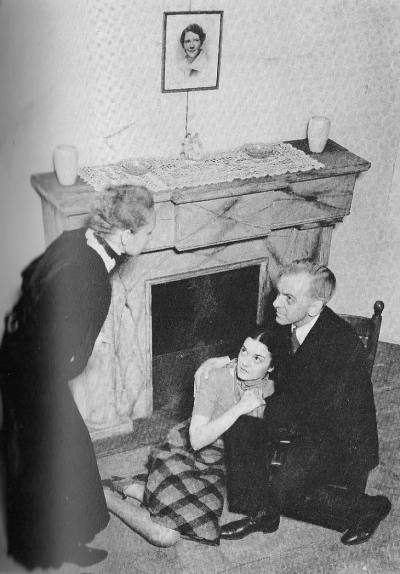
The 1938 production of “Bill of Divorcement” with Sam Alyner, Pauline Bullark at right (woman at left is unidentified).
RLT opened its 1937-38 season with a production of the classic melodrama “East Lynne.” presented November 3, 4 and 5 in the Murphey School Auditorium with Katherine Metcalf and Bill Smith in leading roles, The News and Observer reported that the play was done “as a take-off on the exaggerated emotions of the Victorian era, and so well did the actors succeed in their purpose of making ludicrous the most sacred of emotions, that the scattered on-lookers were hilarious most of the time.”
For contrast the theatre followed up with performances of a serious play, “Bill of Divorcement,” December 9 at State College’s Pullen Hall, to an audience of 300 people. The N&O review was lukewarm: “The brilliant spots in ‘Bill of Divorcement’ … failed to lift the performance greatly above the ‘run of the mill’ type of amateur stage production.”
In December 1937, RLT again blazed new trails by cooperating with the Hugh Morson High School Dramatic Club to present a one-act play, “Joint Owners in Spain,” in the Raleigh Little Theatre workshop.
Another innovation was a Christmas play, “The Gift.” done in connection with the Welfare Department’s Christmas party at Caraleigh. The play was directed by RLT’s Wilbur Dorsett with a cast of children from Eliza Poole School in Caraleigh.
January 1938 saw an exchange of plays with the Rocky Mount Little Theatre. On January 11, RLT presented “East Lynne” at the Rocky Mount High School. and on January 21 the Rocky Mount theatre group performed “The Ghost Train” under RLT’s auspices at Needham Broughton High School.
Meanwhile, rehearsals and backstage preparation had been going forward on an ambitious project the Raleigh Little Theatre production of Offenbach’s opera, “The Tales of Hoffman.” Madge Noble and Lillian Waldo designed and sewed costumes for principals and a 40-member chorus, while Evelyn Payne designed sets. The opera was presented March 11, 1938, at Hugh Morson High School, and The N&O reviewer, Carl Thompson, reported: “Many a skeptic who went to scoff came away marveling at the entertainment provided and at the comparative smoothness of the musical drama.” More than 1,200 people saw the opera.
Lulu Vollmer’s “Sun-Up” was scheduled next, but the production was canceled to give a world premiere to a new play by Ann Preston Bridgers, “Carrie Was a Lady.” the story of a woman named Carrie who had married 10 soldiers during the war to collect their insurance. With Miss Bridgers directing, the play was performed April 26, 1938, at Broughton High School. Mary Dudley Pittman, The Raleigh Times critic, was enthusiastic: “Carrie was a lady! She was such a fine lady the Raleigh Little Theatre should present her again and again until everybody has met her.”
Miss Bridgers also had been busy on another front. On March 2, 1938, she appeared before the Raleigh Junior League and asked for that group’s support in obtaining a permanent home for the Raleigh Little Theatre. (The struggle to bring that dream to reality is a story told in the next chapter, a tale of red tape run rampant.)
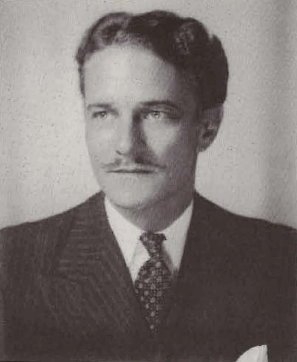
John Fuldner, Fourth Director of Raleigh Little Theatre, 1938-1939
The 1938-39 season opened with a change in RLT directors. Wilbur Dorsett resigned to join W. Raymond “Teacher” Taylor in the fast-developing drama department at what was then Woman’s College of the University of North Carolina at Greensboro. Dorsett was succeeded by John Fuldner, on loan from the New York Federal Theatre project. Fuldner had been a motion picture actor with the German film company UFA and had both amateur and professional stage experience, including appearances with the Robin Hood Theatre in Arden, Delaware.
Fuldner’s first play at RLT was “As Husbands Go.” a comedy by Rachel Crother, presented November 28, 1938, at Broughton High School. Jack Criswell and Pauline Bullock played leading roles; sets were designed by Jane Hall, later art editor of The News and Observer.
After a Christmas play, presented in cooperation with Edenton Street Methodist Church, and workshop productions, RLT’s next major effort was the play “The Night of January 16th.”
It was, to say the least, an unusual production. There were 20 people in the cast and another 15 working backstage. Permission was obtained to perform the play in the Wake County Courthouse, assuring an authentic setting for the courtroom drama.
The production was not without controversy. The courthouse was announced as the site of the play, then county officials refused permission for use of the building, saying similar requests by other groups had been denied. Then another switch was made and the play went off as scheduled at the courthouse. It was a rousing success. A reporter for The News and Observer, Edith Harbour, wrote:
“A jury drawn from the audience deliberated only five minutes before returning a verdict directly contrary to the evidence in the case tried last night in Superior Court room of the Wake County Courthouse when the Raleigh Little Theatre … presented “The Night of January 16th.” (The playwright, Ayn Rand, has written alternate endings for the show, depending on how the jury voted.)
“… So crowded was the courtroom last night that many spectators stood and the window ledges were crowded.
“… The jurors selected from the opening night audience were Mayne Albright, Miss Daisy Ward, Frank Daniels, Elvey Thomas, W. Lunsford Long, Robert C. deRosset, Miss Helen Morton, Graham Ansel, David Stowe, John Lang, Miss Isabel Hoey and Miss Cornelia McKimmon.
“… Carl Thompson as District Attorney Flint carried the burden of the play on his shoulders and walked away with acting honors.
“… As the woman on trial for her life, Mrs. Charles Hazel gave a splendid performance, especially in the third act when-but that would be telling the story and spoiling the play for those who will see it tonight…”
More than 650 people saw performances of “The Night of January 16th” making it one of RLT’s most successful productions up to that time.
The courtroom drama was but the opening gun in an extremely ambitious year for the Little Theatre. Another opera, Verdi’s “Il Trovatore,” a joint production of the Raleigh Opera Company and RLT, was presented March 18 and 21, 1939, at Broughton High School, with Edwin Mill, Florence Boone and Cantey Sutton in principal roles.
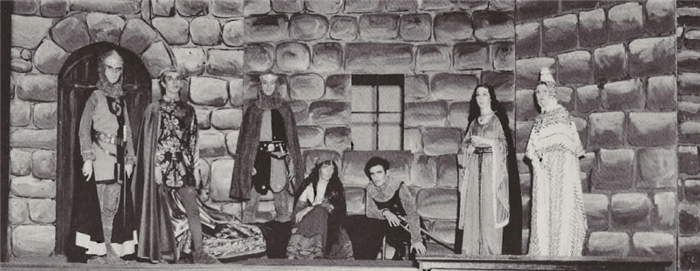
Raleigh Little Theatre production of the opera “Il Trovatore” in 1939
“Il Trovatore” drew national attention to the Raleigh Little Theatre. The New York Times reported: “Down in Raleigh, N.C., the Little Theatre found so many opera-minded persons in the community that it organized an opera group, which after long and heroic training, presented ‘Cavalleria Rusticana’ two seasons ago.” The News and Observer said “Il Trovatore” was “the most ambitious undertaking of the Little Theatre to date … the most finished performance given by that group.”The Indianapolis News carried a story beginning: ”A meter reader, a traveling salesman, a stenographer and a social registerite play the leading roles in amateur productions of grand opera at Raleigh, N.C.” The Washington Times-Herald and the Des Moines Sunday Register in Iowa also devoted full-page spreads to Raleigh’s ambitious Little Theatre.
More honors came to RLT March 23-25, 1939, when the theatre won first prize for little theatres in the 16th annual state drama festival at the University of North Carolina, as well as first prize for costume design.
The Raleigh Little Theatre next grasped boldly a dramatic thistle, producing “Strike Song,” an original play written and directed by Loretto Carroll, a former Carolina Playmaker It was based on the story of Ella May Wiggins, the ballad singer who died in the Gastonia, North Carolina, textile strike of 1929. Jack Riley, The News and Observer critic, wrote:
“… After three hours on the scenes of the Gastonia strike and its bloody consequences, thinking patrons of the play reached the conclusion that organized labor and unyielding employers suffer a deficiency common in other struggles–lack of reason.
“… The Little Theatre group can chalk up another success in ‘Strike Song.’ From the standpoint of a producer, the performance accomplished all that can be achieved through a propaganda play. It set the audience to thinking.”
Then, in what might be called a look into ”a cloudy crystal ball” in the light of the 1980s and successful efforts to break strikes, Riley noted the impact of President Franklin D Roosevelt:
“The strike at Needham Broughton last night did not produce the alarm it might have occasioned prior to 1933. Since then, the United States has found a new leader and in him a humanitarian view of labor. The right of collective bargaining is no longer challenged by reasonable industrialists, but likewise the labor-capital issue is reduced to the same elements of other dealings – reason and calm, neither of which found much place in ‘Strike Song’.”
The next production of RLT, Ferenc Molnar’s “The Swan,” was performed June 6 at Hugh Morson High School. According to The N&O critic, the production “fell far below the standard maintained throughout the year … a bad choice to end the year’s series of brilliant plays.”
The final production of the year was not a play but an opera, von Flotow’s “Martha,” and it formally opened a new amphitheatre. (Only the basement had been dug for the new RLT building.) The choice was a happy one since many of the scenes in the opera were out-of-doors-at a country fair and in a hunting park. Leading roles were sung by Elizabeth Gantt, Robert G. Hicks, Horace Seeley, Robert Covington and Sherwood Jones.
Edith Harbour of The N&O was ecstatic: “There were moments of almost indescribable beauty as voices, costumes and setting combined to create a particular moment or mood, and these were emphasized rather than offset by moments when the action dragged.”
As for the amphitheatre itself, Miss Harbour wrote: “Nowhere else in the United States has a Little Theatre built such a drama center to serve its own and a community’s needs. Probably nowhere else in the United States has a Little Theatre group had its eye more steadily on the future of drama as a community enterprise.”
It was a triumphant finale to the Little Theatre’s third season. But there was trouble ahead:
-In the summer of 1938, the Federal Theatre of the WPA was discontinued. The Raleigh Little Theatre lost its director, John Fuldner, and its costumer, Lillian Waldo.
-The amphitheatre had been completed, but completion of the theatre building, the centerpiece of RLTs dreams, was bogged down in a swamp of bureaucracy and red tape.
Next, the story of the building and a very determined woman who knocked a few heads together, used her considerable charms at persuasion and got the project back on the track.